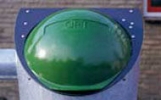
- Agricultura
- Industrie alimentara
- Automotive
- Aeronautica, transport aerian
- Celuloza si hartie
- Chimie si petrochimie
- Constructii de masini
- Farmaceutica, cosmetica
- Electronica, electrotehnica
- Industrie textila
- Invatamant si cercetare
- Instalatii de ridicat
- Mase plastice, cauciuc
- Materiale constructii
- Medicina, laboratoare
- Petrol si gaze
- Industria lemnului, mobila
- Publicitate
- Reciclare deseuri
- Tehnologia informatiei
- Transport
- Entertainment, sport
- Constructii navale
- Cai ferate
- Bunuri larg consum
- Utilitati
- Altele
- Industrie extractiva
The Netherlands based Orlaco Vision has developed a fully electronically-controlled station for the underground storage of household refuse with the first system going on line in the rural district of Vlissingen. The system provides a clean, efficient, honest (the polluter pays) and easy-to-use solution for the disposal of domestic waste.

Reality
The idea of the underground storage of refuse is not a new one and even before World War II numerous big cities used systems based on a similar concept. But only recently has the idea become a reality in the Netherlands, with around ten suppliers of underground refuse containers active within the country. "There are some disadvantages attached to the basic concept," admits Henrie van Beusekom, managing director of Orlaco Vision. "The existing systems are easily accessible which can lead to a fast build-up of refuse and if the refuse container is full, people tend to deposit their refuse next to it. This causes street litter and hygiene problems. What's more, there is no way of telling who deposits what, which is in direct conflict with the principle 'the polluter pays'
Electronic solution
Orlaco Vision, was asked by the sanitation departments of a number of Dutch rural districts for an alternative to existing underground collecting stations. "Basically, there were three considerations," van Beusekom says. "Access control, level measurement and a registration function. And these factors could only be successfully addressed electronically. Orlaco Vision developed a console for electronic user identification, weighing andregistration of the refuse and measurement of the refuse level. The console monitors two throw-in shafts, one for vegetable, fruit and garden refuse and another for 'dry' refuse. The whole process is controlled from a central pillar that contains all the necessary technology required to operate and monitor the system.
Chip purse
The system is very easy to use. The user inserts a magnetic card which contains a chip purse into the pillar. The user details and the credit balance is then checked and once authorised the user is able to access the throw-ins and dump the refuse into the container. A weighing appliance determines the weight of the refuse and withdraws the dump costs from the card balance. A computer at the sanitation department connects to the refuse station by modem each day, monitors the containers and notifies the department of any containers that need to be collected and emptied.
Omron's total solution
At the heart of the system are Omron's pillar electronics. Key parts are the CQM1 PLC's controlling moving parts, the SGR cardreaders and the appliance for the electronic weighing of the bin bags. Van Beusekom commented "We chose Omron because they are able to offer us a total solution, including the required power supplies, sensors and relays and, because it is a development project, we wanted one point of contact and a short communications line. Co-operative partners in the project were engineers Hiddinga Heijckmann of Arnhem. They developed the software for the system with the help of SYSWIN, Omron's software package for PLC's.
Efficiency
The first system went on line in Vlissingen on November 21st 1997. Peter Stok, the local public relations official, explains: "We are convinced that these systems are the future of domestic waste disposal. Besides being more hygienic and convenient for the users, as a rural district we can see the potential for important efficiency profits. Existing arrangements require three men for one collecting vehicle; with the new container system only the driver is required and this will mean substantial savings can be achieved over the long term."
- Climatizare, ventilatie
- Ambalare
- Asamblare, roboti
- Infasurare, desfasurare
- Control dimensional
- Control proces
- Control temperatura
- Etichetare
- Galvanizare
- Imbuteliere
- Inspectie vizuala
- Presare
- Injectie, matrite
- Malaxare, dozare
- Cuptoare si tratament termic
- Monitorizare wireless
- Pompare, ventilare
- Platforme testare
- Presare
- Sincronizare axe
- Spalare
- Taiere la lungime
- Conveioare si transport material
- Instalatii de ridicat
- Urmarire productie
- Contorizare productie
- Citire cod de bare si 2D
- Automatizari diverse
- Linii fabricatie
- Tratare apa
- Sisteme automatizare
- Actionari electrice
- Senzori
- Traductoare si detectoare
- Componente safety Omron
- Componente control
- Componente comutatie
- Dispozitive semnalizare
- Componente safety Pilz
- Interfete de automatizare
- Dataloggere
- Inregistratoare
- Rezistente de franare
- Sisteme de distributie
- Echipamente de retelistica industriala
- Analizoare si contoare energie
- Termometre in infrarosu
- Tablouri electrice




















